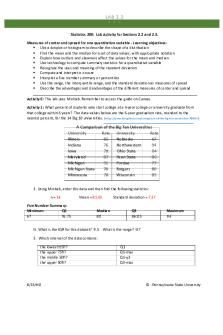Stat Lab 2.4 and 2.5 PDF

| Title | Stat Lab 2.4 and 2.5 |
|---|---|
| Course | Elementary Statistics |
| Institution | The Pennsylvania State University |
| Pages | 3 |
| File Size | 118 KB |
| File Type | |
| Total Downloads | 74 |
| Total Views | 143 |
Summary
Stat lab 2.4 and 2.5 - use for reference...
Description
LAB 2.4 &25 Statistics 200: Lab Activity for Sections 2.4 and 2.5 Relationships between variables - Learning objectives:
Use a boxplot to describe data for a single quantitative variable Identify outliers from a boxplot Use a side-by-side graph to visualize a relationship between quantitative and categorical variables Examine a relationship between quantitative and categorical variables using comparative summary statistics Describe an association displayed in a scatterplot Explain what a positive or negative association means between two variables Interpret a correlation Use technology to find a correlation Recognize that correlation does not imply cause and effect Recognize that you should always plot your data in addition to interpreting numerical summaries
Activity 1: Positive or negative? In each example below, do you expect a positive or negative association between the two quantitative variables? 1. Number of years of education and annual salary, for US adults positive 2. Age and maximum running speed, for adults. negative 3. Age and maximum running speed, for children. positive 4. Age of the spouse1 and age of the spouse2, for married couples 5. Number of letters in a signature and the Words with Friends score of those letters positive Activity 2: Practice with correlation Part of understanding associations between quantitative variables is being able to rank scatterplots based on their correlation. A great way to practice is using the website: http://istics.net/Correlations/. Try to reach a streak of 30 correct guesses! Hint: there will be something similar on your lab quiz! Activity 3: Visualizing relationships with graphs We are now going to explore the letter / points data from you and your classmates. The data resides in a Google Sheet accessed through Canvas (see the submodule for this section), and can be analyzed in Minitab. Open Minitab on your computer and copy-paste the columns from the Google Sheet into Minitab. 1. Create a boxplot for how many letters per signature.
8/13/20
© Pennsylvania State University
LAB 2.4 &25 a. Approximately what is the median? 12 b. Are there outliers? yes c. Can you tell from this boxplot how many students entered data? no d. Approximately what is the shape of this data? symmetrical 2. Now create side-by-side boxplots for letters per signature, considering the gender identification response (Woman, Not Woman). How do the following quantities vary between Woman and not woman respondents? Your answer should be along the lines of ‘approximately equal for both groups’, or ‘median number of letters per signature is much higher for the not women group. a. b. c. d. e.
Median about the same Range range is larger for women Maximum max is larger for women IQR about the same Skewness about the same, symmetrical
3. Now we will explore the relationship between the two variables ‘letters per signature’ and ‘points’. a. Are these variables categorical or quantitative? quantitative b. Which of these variables should be the explanatory variable? Letters per signature 4. Create a scatterplot of ‘letters per signature’ and ‘points’. Be sure to put the explanatory variable on the x-axis! a. Characterize the association between these two variables. positive b. What is the correlation? .673 c. Does association between variables differ when comparing males to females? no Again create a scatterplot, but this time select the ‘with groups’ option, and enter in sex as the group variable. What do you see? Does it look like the trend is the same for the two groups? Trend is the same
8/13/20
© Pennsylvania State University
LAB 2.4 &25
Activity 4: Identify what shape should be attached to each boxplot when considering three samples: A, B, C.
Three Boxplots A
B
C
2
8/13/20
6
10
14
18
© Pennsylvania State University...
Similar Free PDFs

Hiragana 24-25
- 2 Pages

Stat Lab 2.2 and 2.3
- 4 Pages

Chapter 24 & 25 Notes
- 11 Pages

Stat Lab 2.4 and 2.5
- 3 Pages

Stat Lab 6.1 and 6.3
- 4 Pages

Lecture 24-25-26 Memory
- 14 Pages

Temas 24 Y 25 bioquimica
- 3 Pages

excel stat- lab 1
- 2 Pages

Stat 240 LAB 1
- 4 Pages

Case 24 25 26 - case brief
- 4 Pages

Makalah PPH pasal 24 dan 25
- 13 Pages

Exp. 25 Lab Report
- 11 Pages
Popular Institutions
- Tinajero National High School - Annex
- Politeknik Caltex Riau
- Yokohama City University
- SGT University
- University of Al-Qadisiyah
- Divine Word College of Vigan
- Techniek College Rotterdam
- Universidade de Santiago
- Universiti Teknologi MARA Cawangan Johor Kampus Pasir Gudang
- Poltekkes Kemenkes Yogyakarta
- Baguio City National High School
- Colegio san marcos
- preparatoria uno
- Centro de Bachillerato Tecnológico Industrial y de Servicios No. 107
- Dalian Maritime University
- Quang Trung Secondary School
- Colegio Tecnológico en Informática
- Corporación Regional de Educación Superior
- Grupo CEDVA
- Dar Al Uloom University
- Centro de Estudios Preuniversitarios de la Universidad Nacional de Ingeniería
- 上智大学
- Aakash International School, Nuna Majara
- San Felipe Neri Catholic School
- Kang Chiao International School - New Taipei City
- Misamis Occidental National High School
- Institución Educativa Escuela Normal Juan Ladrilleros
- Kolehiyo ng Pantukan
- Batanes State College
- Instituto Continental
- Sekolah Menengah Kejuruan Kesehatan Kaltara (Tarakan)
- Colegio de La Inmaculada Concepcion - Cebu



